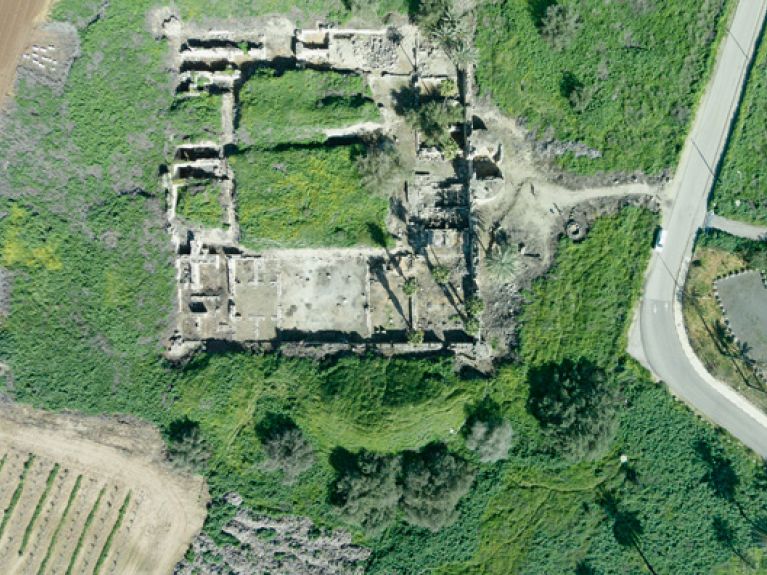Mysterious ruins on the Sea of Galilee
The Federal Foreign Office Cultural Preservation Programme is enabling a German-Israeli team of archaelogists to research a Umayyad castle steeped in history.

The history of excavation work at Khirbat al-Minya (Horvat Minim) all began with a mistake at the end of the 19th century. If this error had not occurred, today archaeologist Hans-Peter Kuhnen would not travel from Germany to Israel several times a year to conduct research into the ruins on the shore of the Sea of Galilee. Without this mistake, people would never have discovered how important they are. The ruins are located on the northern shore of the lake. When European researchers first discovered them there and found no evidence of churches or synagogues dating from late antiquity, they assumed that they must be the remains of Capernaum, the fishing village in which Jesus lived and from which five of his disciples came. For Christian researchers from all over the world, it was a location of the greatest interest. In 1895, a German association called Deutscher Verein vom Heiligen Land zu Köln purchased the land. For roughly nine years, its members were able to enjoy the belief that they owned Capernaum – until the real Capernaum was discovered ten kilometres to the east.
But what had they actually bought? In 1911, Catholic archaeologists began excavating the ruins to find out. In the course of several digs until the beginning of the Second World War they uncovered the foundation walls of an enormous building: a square castle with roughly 70-metre-long ramparts, with defensive towers at the corners and in the middle of the walls, with mosaics, with coronation rooms and – one of the oldest mosques in the Holy Land. “The location is one of the most significant Islamic archaeological sites in Israel,” says archaeologist Hans-Peter Kuhnen, who heads the Institute of Ancient Studies at the University of Mainz. Khirbat al-Minya is a so-called desert castle dating from the early eighth century. It is a castle of the Umayyad caliphs, who began to rule the region from Damascus in 661. As such it is “one of the key places at which you can study the transition between the Byzantine and the Islamic era”. That is because many other desert castles were built over, and written sources from that time are rare.
The ruins of Khirbat al-Minya reveal, for example, how Muslim rulers treated other religions. It becomes clear that they decided not to build the castle on the nearby pilgrim church of Taiga, but away from it. The churches and synagogues in the surrounding area were not destroyed. “Findings of this kind are more important than ever today where the concept of the caliphate is used very differently,” says Kuhnen. Nevertheless, the ruins face difficulties. Hardly any tourists find their way here among a plethora of Jewish and Christian sights. At the same time, it is being affected by plant growth and erosion. Since Kuhnen first researched the location with students in 2009, its state has increasingly deteriorated. “In some places the limestone is so crumbly that you can poke a hole through it with your finger.”
The problem is that the Israel Nature and Parks Authority that has leased the site from the German association is an independent operator which has to finance the preservation of its many historical sites out of its own funds. There is no government funding for the architectural monument. Nevertheless, in 2015, Kuhnen began restoring the structure and is also continuing the project in 2016 – with a total of 92,000 euros from the Federal Foreign Office Cultural Preservation Programme. Since 1981, as part of Germany’s international cultural relations and education policy, this programme has been supporting initiatives around the world that aim to preserve cultural heritage. The projects range from the digitalisation of Namibian pop music to the conservation of Islamic manuscripts in Timbuktu and the restoration of the former Beth-El Synagogue in São Paulo, Brazil – in all, over 2,700 initiatives in 144 countries have been supported so far.
The money also helps Khirbat al-Minya indirectly. The funding from Germany makes is easier for Israeli partners to contribute money and personnel. “I’m glad the Federal Foreign Office has sent out a clear message with this funding,” says Kuhnen. As a result, German and Israeli experts always work together at the site. Work is planned to continue in September 2016. A team of construction researchers from the RheinMain University of Applied Sciences in Wiesbaden will then begin with a deformation-true survey of the architectural structure. Stays in Israel are almost routine for Kuhnen, who completed his doctorate in 1982 with a thesis on the Roman settlements in the Mount Carmel range, did his alternative civilian service with Action Reconciliation Service for Peace and speaks fluent Hebrew. For the students who accompany him it is often their first contact with a country that they have usually previously only associated with negative news.
When Kuhnen’s student assistant Nina Termin flew to Israel for the first time in 2012, her parents said: “We have so many beautiful Roman things here, you really don’t need to leave!” But Nina Termin wanted to. Because: “Nothing can replace a 360-degree view of the landscape.” Neither photographs nor excavation reports. Since 2014 the 25-year-old researcher has now come here five times – and in the process has not only explored the past. Once she rented a room for three weeks with an older, ultraorthodox woman, who took her to a Sabbath meal with a sofer, a Torah scribe. “Experiencing that was enriching,” says Termin.
Later they visited Khirbat al-Minya together. Her host did not know the ruins, although she lives in the vicinity. That is not surprising. The complex only had a minimum of signs, and there was no signpost indicating the site from the road. If Kuhnen and Termin have their way, that should be further improved. “We want to show that there is much more here than thorny bushes and palms,” says Kuhnen. After all, Khirbat al-Minya does not need yet another mistake. ▪
